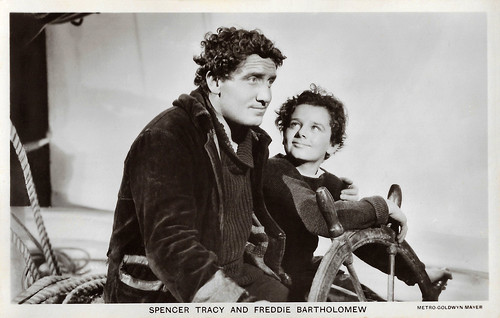
British Real Photograph postcard, London, no. FS 153. Photo: Metro Goldwyn Mayer (MGM). Spencer Tracy and Freddie Bartholomew in Captains Courageous (Victor Fleming, 1937).
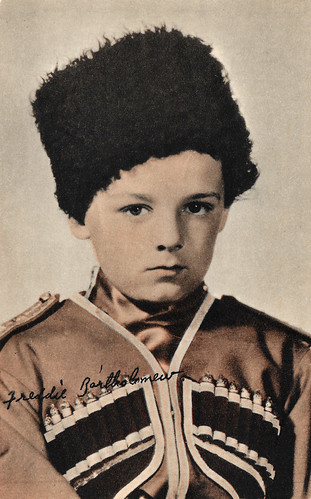
British postcard in the A Real Photogravure Portrait series. Photo: MGM. Freddie Bartholomew in Anna Karenina (Clarence Brown, 1935).

British postcard by De Reszke Cigarettes, no. 6. Photo: Metro-Goldwyn-Mayer (MGM). W.C. Fields and Freddie Bartholomew in David Copperfield (George Cukor, 1935).
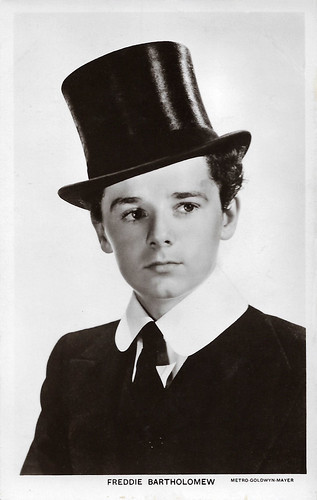
British postcard. Photo: MGM. Freddie Bartholomew in Little Lord Fauntleroy (John Cromwell, 1936).
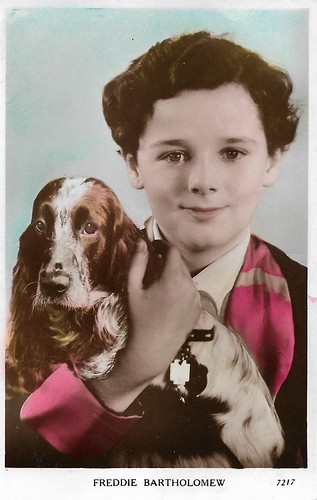
British Real Photograph postcard by Valentine's, no. 7217.
Reciting and performing on stage at three years of age
Frederick Cecil Bartholomew was born in Harlesden, London, in 1924. He was the son of Lilian May (Clarke) and Cecil Llewellyn Bartholomew. He was abandoned by his alcoholic parents when he was a baby. From age three, he grew up in the town of Warminster under the care of his unmarried aunt Millicent. A precocious lad, Freddie was reciting and performing on stage at three years of age and was soon singing and dancing as well.
By age six he had appeared in his first film, a short called Toyland (Alexander Oumansky, 1930). Three other British film appearances and the recommendation of his teacher Italia Conti led him to be cast by MGM in the lavishly produced adaptation of Charles Dickens's The Personal History, Adventures, Experience, & Observation of David Copperfield the Younger (George Cukor, 1935), as the title character. It resulted in a seven-year MGM contract and a move to Hollywood with his aunt.
The illustrious, star-studded and highly successful David Copperfield (George Cukor, 1935) made Freddie an overnight sensation, and he went on to star in a succession of high-quality films through 1937, including Anna Karenina (Clarence Brown, 1935) with Greta Garbo, Professional Soldier (Tay Garnett, 1935), the riveting Little Lord Fauntleroy (John Cromwell, 1936), Lloyds of London (Henry King, 1936), and The Devil Is a Sissy (W.S. Van Dyke, 1936) with Jackie Cooper and Mickey Rooney.
Freddie's biggest success was Captains Courageous (Victor Fleming, 1937), opposite Spencer Tracy. Following the success of Little Lord Fauntleroy (John Cromwell, 1936), Freddie's birth parents, who were strangers to him, stepped in and attempted for seven years to gain custody of him and his fortune. His aunt Millicent attempted to offset these legal expenses and payouts by demanding a raise in Freddie's MGM salary in 1937. Freddie was protected by the so-called "Coogan Law," which was supposed to prevent parents from stealing the earnings of child performers, but every time his mother filed suit, he was forced to expend money from the trust fund defending against her, and after a half-dozen or more times, his trust was very much depleted.
Another slew of court cases ensued, this time over the MGM contract, and Freddie missed a critical year's work and some golden film opportunities. By the time he resumed acting work in 1938, he was well into his teens, and audiences grew less interested in literary period pieces as World War II erupted in Europe. Following Kidnapped (Alfred L. Werker, 1938), many of his ten remaining films through 1942 were knock-offs or juvenile military films, and only two were for MGM. The best of the films after Kidnapped (Alfred L. Werker, 1938) were Lord Jeff (Sam Wood, 1938), Listen, Darling (Edwin L. Marin, 1938) with Judy Garland, Swiss Family Robinson (Edward Ludwig, 1940), and Tom Brown's School Days (Robert Stevenson, 1940). His salary soared to $2,500 a week making him filmdom's highest-paid child star after Shirley Temple.
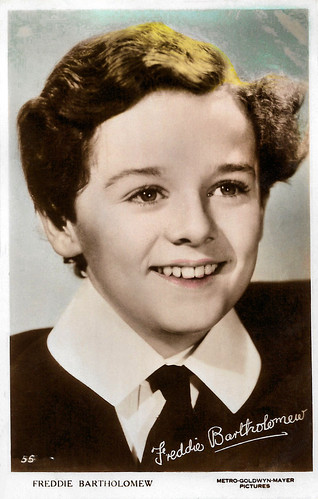
British postcard by Art Photo, no. 55. Photo: Metro-Goldwyn-Mayer. Freddie Bartholomew in Little Lord Fauntleroy (John Cromwell, 1936).
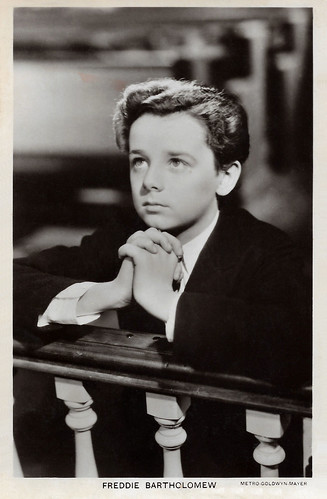
British postcard in the Picturegoer Series, London, no. 1175.

British postcard in the Picturegoer Series, London no. 1175a. Photo: Metro-Goldwyn-Mayer. Freddie Bartholomew in Captains Courageous (Victor Fleming, 1937).
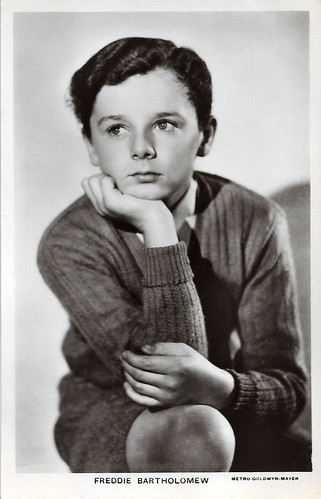
British postcard in the Picturegoer Series, London, no. 920a. Photo: Metro-Goldwyn-Mayer (MGM).

British Real Photograph postcard. no. 117. Photo: Metro-Goldwyn-Mayer.
Damaged psychologically
|n 1944, at the age of 20, Freddie Bartholomew was drafted into the U.S. Army Air Force, assigned as an aircraft mechanic, and while doing repairs that year on a bomber engine, he fell from a scaffold and broke his back. He spent a year in traction at a G.I. hospital and was given a medical discharge in 1945, seemingly recovered. Unknown to himself and all but a tiny handful of those closest to him, however, he had been damaged psychologically by the injury and the recovery period and American citizenship.
The additional time away from the screen had not done him any favours, though, and efforts to revive his film career were unsuccessful. He tried to resume his career with the low-budget PRC feature The Town Went Wild, never realizing that he was deeply mentally ill. When that film failed to revive his movie career he turned to the stage, and his one effort at performing in a play, in Los Angeles, was ignored by everyone but the critics, who hated it. His mental condition was exacerbated by the tone and venom of their reviews.
Worse still, he ended up marrying the publicist for the production, Maely Daniele, a Russian immigrant who was trying to escape deportation and needed the protection of the American citizenship that Bartholomew had been granted through his military service. Aunt Millicent left for England when Freddie married Daniele in 1946 against her wishes. At one point, with all but a tiny bit of his money spent, the couple was living in a car parked on the streets of Brooklyn. It was in those bad years that he made another attempt at film work, playing himself in Sepia Cinderella (Arthur H. Leonard, 1947).
Freddie toured a few months in Australia doing nightclub singing and piano, but when he returned to the U.S. in 1949 he switched to television, making a gradual move from performer to host to the director, at New York station WPIX. He also made one final big-screen appearance, portraying a priest in St. Benny the Dip (Edgar G. Ulmer, 1951), a strange, whimsical drama shot on the Lower East Side of New York. In 1954, re-married to TV cookbook author Aileen Paul, and he moved to Benton & Bowles advertising agency, as a television director and producer. He remarked at the time that the millions he had earned as a child had been spent mostly on lawsuits, many of which involved headline court battles between his parents and his aunt for custody of young Freddie and his money. "I was drained dry," he said.
He became vice president of television programming in 1964, directing and producing several prominent long-running soap operas, including As the World Turns and Search for Tomorrow. Bartholomew retired due to emphysema by the late 1980s, and eventually moved with his third wife Elizabeth to Florida, where he died in Sarasota in 1992, but not before being filmed in several interview segments for the lengthy documentary, MGM: When the Lion Roars (Frank Martin, 1992). He had two children with Aileen Paul, Kathleen Millicent Bartholomew (1956) and Frederick R. Bartholomew (1958). Composer Jesse Zuretti is his grandson.

British Real Photograph postcard, no. B.2. Photo: Metro-Goldwyn-Pictures.
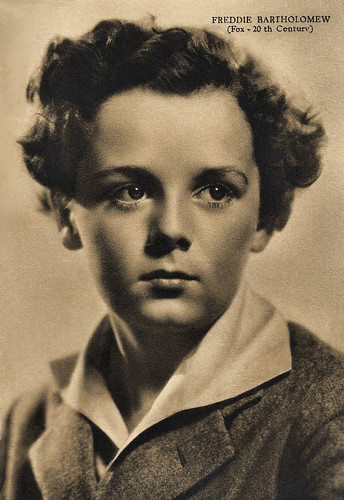
Italian postcard by Rizzoli & C., Milano, 1936 XV. Photo: Fox - 20th Century.
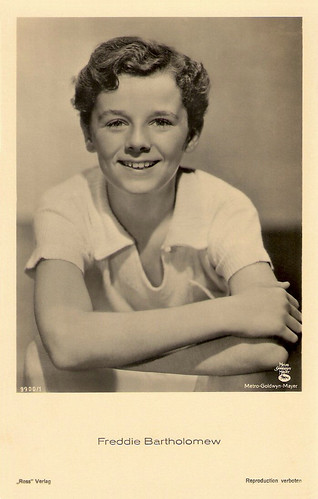
German postcard by Ross Verlag, no. 9900/1, 1935-1936. Photo: Metro-Goldwyn-Mayer (MGM).

Italian postcard.

German postcard by Ross Verlag. Photo: Metro-Goldwyn-Mayer.
Sources: Bruce Eder (AllMovie), Wikipedia and IMDb.
No comments:
Post a Comment